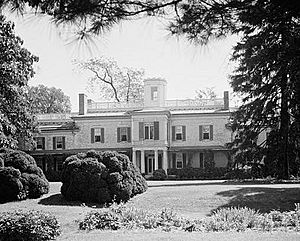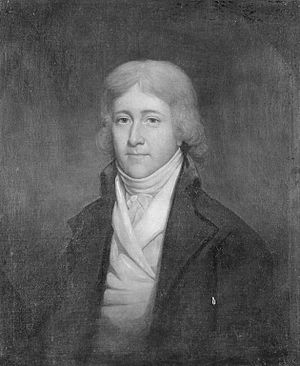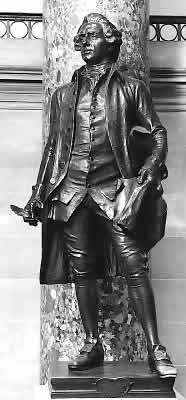Charles Carroll of Carrollton facts for kids
Quick facts for kids
Charles Carroll
|
|
|---|---|
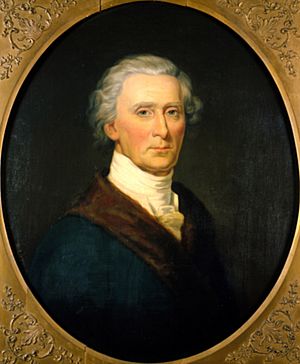
Charles Carroll painted by Michael Laty
|
|
| United States Senator from Maryland |
|
| In office March 4, 1789 – November 30, 1792 |
|
| Preceded by | Office created |
| Succeeded by | Richard Potts |
| Member of the Maryland Senate | |
| In office 1781–1800 |
|
| Personal details | |
| Born | September 19, 1737 Annapolis, Maryland, British America |
| Died | November 14, 1832 (aged 95) Baltimore, Maryland, U.S. |
| Nationality | Kingdom of Great Britain (1737–1776) United States (1776–1832) |
| Political party | Federalist |
| Spouse | Mary Darnall |
| Alma mater | College of St. Omer Lycée Louis-le-Grand |
| Signature | |
Charles Carroll (born September 19, 1737 – died November 14, 1832) was an important American politician. He is often called Charles Carroll of Carrollton to tell him apart from others with the same name. He was one of the brave people who signed the United States Declaration of Independence.
Carroll was the only Catholic to sign the Declaration. He also lived the longest among all the signers, passing away 56 years after the Declaration was signed. He is known as one of the Founding Fathers of the United States.
People at the time called him the "First Citizen" of the American Colonies. This was because he wrote articles in the Maryland Gazette using that pen name. He served in the Continental Congress and later became the first U.S. Senator for Maryland.
Many believed Carroll was the wealthiest and most educated of all the Declaration signers. He studied for 17 years in France with the Jesuits. Because of this, he could speak five languages very well.
Born in Annapolis, Maryland, Carroll inherited huge farms. He was considered the richest man in the American colonies when the American Revolution began in 1775. His wealth was about £2.1 million, which would be like $375 million today. He also owned a large estate in Maryland called Doughoregan, which was about 10,000 acres.
Even though his religion prevented him from holding public office in Maryland, Carroll became a strong leader for independence. He helped establish the Baltimore and Ohio Railroad later in his life.
Contents
Early Life and Education
Charles Carroll was born on September 19, 1737, in Annapolis, Maryland. He was the only child of Charles Carroll of Annapolis and Elizabeth Brooke. His parents married in 1757.
Young Charles went to a Jesuit school called Bohemia Manor in Maryland. When he was 11, he went to France for more schooling. He studied at the College of St. Omer and later at the Lycée Louis-le-Grand in Paris, finishing in 1755. He continued his studies in Europe and learned about law in London. He returned to Annapolis in 1765.
Charles Carroll of Annapolis gave his son, Charles Carroll, a large piece of land called Carrollton Manor. This is why he became known as "Charles Carroll of Carrollton." Like his father, Carroll was Catholic. At that time, Maryland laws stopped Catholics from holding political office, practicing law, or even voting. Despite this, he became one of the wealthiest people in the colonies. He owned many farms, including the large Doughoregan estate.
Role in the American Revolution
Speaking Up for Independence
Carroll was not very interested in politics at first. Also, Catholics were not allowed to hold office in Maryland since 1704. But as the disagreements between Great Britain and its American colonies grew in the early 1770s, Carroll became a powerful supporter of independence.
In 1772, he debated in anonymous newspaper letters. He argued that the colonies had the right to control their own taxes. Writing in the Maryland Gazette as "First Citizen," he spoke out against the governor's decision to raise legal fees. His opponent, writing as "Antillon," was Daniel Dulany the Younger, a famous lawyer who supported the British.
Carroll argued that Maryland's government was controlled by just a few families. As people learned who "First Citizen" was, Carroll's fame grew. He became a leading opponent of British rule. He also served on various committees that helped spread information among the colonies.
In the early 1770s, Carroll believed that only fighting could solve the problems with Great Britain. He once told Samuel Chase, another signer of the Declaration, that arguments would only make people ready for war.
Serving in Congress
Carroll started representing Maryland in pre-revolutionary groups in 1774. He became a member of Annapolis' first committee of safety in 1775. He was also a delegate to the Annapolis Convention, which acted as Maryland's government before independence.
In early 1776, Congress sent him on a special trip to Quebec. The goal was to get help from French Canadians against Great Britain. Carroll was a great choice for this mission because he spoke French and was Catholic. He traveled with Benjamin Franklin, Samuel Chase, and his cousin John Carroll. However, the mission was not successful.
Carroll was chosen for the Continental Congress on July 4, 1776. He stayed a delegate until 1778. He arrived too late to vote for the Declaration of Independence. But he was there to sign the official document we see today. After Thomas Jefferson and John Adams died on July 4, 1826, Carroll became the last living signer.
He signed his name "Charles Carroll of Carrollton." This helped tell him apart from his father, "Charles Carroll of Annapolis," and other Charles Carrolls in Maryland. At the time, he was the richest man in America. He had a lot to lose by signing the document, which was an act of rebellion against the King. During his time in the Second Continental Congress, he worked on the board of war. Carroll also gave a lot of his own money to support the American Revolutionary War.
Serving as Senator
Carroll went back to Maryland in 1778 to help set up the new state government. He was asked to return to the Continental Congress in 1780, but he said no. He was elected to the Maryland Senate in 1781 and served there until 1800.
When the United States government was formed, Maryland chose him to be one of its first U.S. Senators. In 1792, Maryland passed a law saying that no one could serve in both the state and national legislatures at the same time. Carroll preferred to stay in the Maryland Senate. So, he resigned from the U.S. Senate on November 30, 1792.
Views on Slavery
The Carroll family owned enslaved people, and Charles Carroll was said to be the largest slave owner in the American colonies when the Revolution began. Carroll believed that slavery was a "great evil." He supported ending slavery slowly, but he did not free his own enslaved people.
He tried to pass a law in the Maryland Senate to gradually end slavery, but it did not pass. In 1828, when he was 91, he became president of the Maryland branch of the American Colonization Society. This group worked to help Black Americans move to African states like Liberia to live free lives.
Later Life and Important Contributions
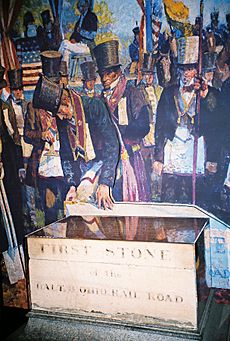
Carroll stopped working in public life in 1801. He was elected a member of the American Antiquarian Society in 1815. Carroll came out of retirement to help start the Baltimore and Ohio Railroad in 1827. This was one of America's first major railroads.
In 1828, he ordered the building of the Phoenix Shot Tower in Baltimore. He laid its first stone. This 234-foot tower was the tallest building in the United States until the Washington Monument was built. Carroll's last public act was laying the "first stone" of the railroad on July 4, 1828. He was almost 91 years old. A song called "The Carrollton March" was written to celebrate this event. It is known as the first train song.
Carroll died on November 14, 1832, in Baltimore, at the age of 95. He lived longer than any other Founding Father. He outlived four of the first six U.S. presidents. His funeral was held at the Baltimore Cathedral. He is buried in his Doughoregan Manor Chapel in Ellicott City, Maryland.
Carroll is remembered in the third part of the former state song Maryland, My Maryland.
- Thou wilt not cower in the dust,
- Maryland! My Maryland!
- Thy beaming sword shall never rust,
- Maryland! My Maryland!
- Remember Carroll's sacred trust,
- Remember Howard's warlike thrust –
- And all thy slumberers with the just,
- Maryland! My Maryland!
Many places are named after him. These include counties in Arkansas, Georgia, Illinois, Indiana, Iowa, Maryland, Mississippi, Missouri, New Hampshire, Ohio, and Virginia. There are also two parishes in Louisiana, East and West Carroll.
Cities and towns named for him are in Georgia, Kentucky, Iowa, Maryland, Missouri, and New York. Neighborhoods in Brooklyn and Tampa are also named after him. Schools like Charles Carroll Middle School in Maryland and Carroll University in Wisconsin honor him too.
In 1876, a special fountain was made for the Centennial Exhibition in Philadelphia. It was called the Catholic Total Abstinence Union Fountain. The fountain has a statue of Moses in the middle. It also has statues of four important Catholics, including Charles Carroll. This fountain is in West Fairmount Park.
In 1903, Maryland placed a bronze statue of Carroll in the United States Capitol's National Statuary Hall Collection. It was sculpted by Richard E. Brooks. In 1906, the University of Notre Dame built a dorm called Carroll Hall. The World War II Liberty Ship SS Charles Carroll was also named in his honor.
Carroll's Family
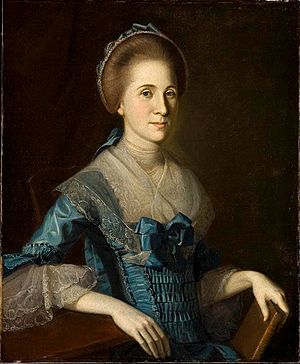
Carroll married Mary Darnall (1749–1782), also known as Molly, on June 5, 1768. They had seven children, but only three lived past infancy:
- Mary Carroll (1770–1846), who married Richard Caton. Their daughters married important figures, including Richard Wellesley, 1st Marquess Wellesley, who was the brother of the famous military leader Arthur Wellesley, 1st Duke of Wellington.
- Charles Carroll Jr. (1775–1825), who oversaw the building of Homewood. He married Harriet Chew.
- Catherine ("Kitty") Carroll (1778–1861), who married Robert Goodloe Harper, a lawyer and U.S. senator.
Today, Carroll's family still owns Doughoregan Manor. It is the largest piece of land in Howard County, Maryland, with over 1,000 acres. This land is very valuable but also protected for its history.
The Story Behind Carroll's Signature
There's a popular story about why Charles Carroll signed the Declaration of Independence as "Charles Carroll of Carrollton." When people signed the Declaration, they were committing an act of treason against King George III. This meant they could be arrested.
The story goes that some signers had unusual names, so they would be easily identified. Others had common names and might hope to avoid being caught. When it was Carroll's turn to sign, he just wrote "Charles Carroll." Someone supposedly said that he risked nothing because there were many Charles Carrolls.
According to this story, Carroll then went back to the desk, grabbed the pen, and added "of Carrollton" to his name. This way, the King would know exactly which Charles Carroll had signed.
However, this story is not true. Carroll had been signing his name "Charles Carroll of Carrollton" for over ten years before the Declaration. He used this to distinguish himself from other Charles Carrolls in Maryland. "Carrollton Manor" was the name of a large piece of land that his family owned and leased to farmers.
See also
 In Spanish: Charles Carroll de Carrollton para niños
In Spanish: Charles Carroll de Carrollton para niños
- 1840s Carrollton Inn
- Annapolis Convention (1774–1776)
- Memorial to the 56 Signers of the Declaration of Independence
- Carrollton Manor
- Maryland in the American Revolution
- O'Carroll
Images for kids


